manual chemistry laboratory
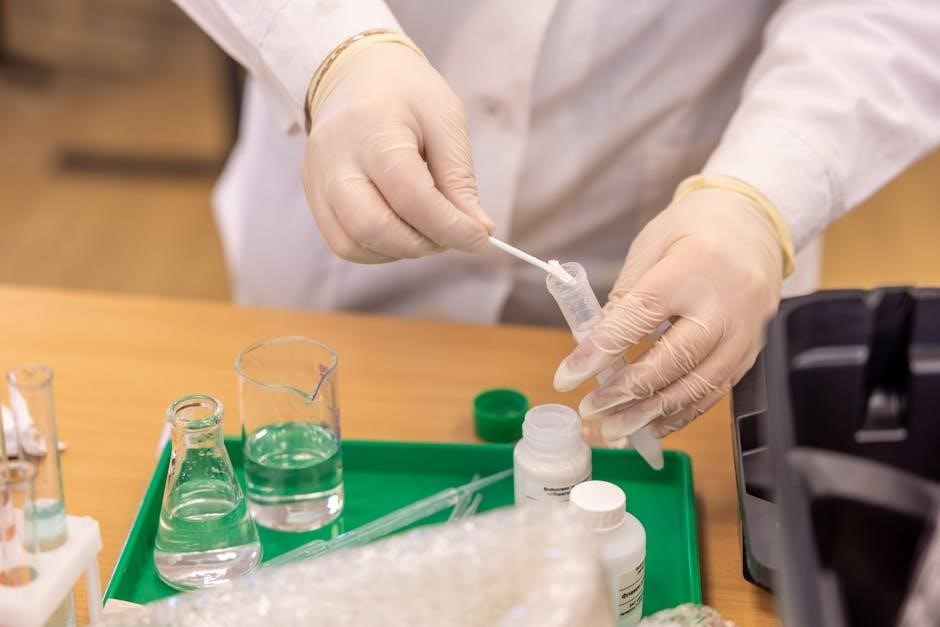
Welcome to the Manual Chemistry Laboratory! This guide provides a comprehensive overview of laboratory practices, safety protocols, and essential techniques for conducting chemistry experiments effectively;
Overview of the Importance of Lab Manuals in Chemistry
Laboratory manuals are essential tools in chemistry education, providing structured guidance for experiments and ensuring safety. They outline procedures, safety protocols, and expected outcomes, helping students master key concepts. Manuals also promote organization, encouraging accurate record-keeping and critical thinking. By standardizing experiments, they facilitate consistent learning experiences and skill development. Additionally, lab manuals serve as central resources for understanding lab techniques, data analysis, and ethical practices, fostering a deeper engagement with chemical principles and practical applications.
Structure and Content of a Typical Chemistry Lab Manual
A typical chemistry lab manual is organized into clear sections, starting with an introduction that outlines objectives and lab policies. It includes safety protocols, emergency procedures, and equipment usage. Each experiment is detailed with materials, step-by-step procedures, and expected outcomes. Data analysis and reporting guidelines are also provided, along with appendices containing supplementary information like conversion tables and safety data sheets. This structured format ensures clarity, safety, and ease of use for students and researchers.
Key Features of a Comprehensive Lab Manual
A comprehensive lab manual includes detailed procedures, safety precautions, and clear objectives for each experiment. It features diagrams, data tables, and spaces for note-taking, fostering engagement and understanding. The manual also covers proper handling of chemicals and equipment, emphasizing environmental and ethical considerations. Additional resources, such as digital simulations and troubleshooting guides, enhance learning. Regular updates ensure relevance, making it an indispensable tool for students and researchers in achieving laboratory success and scientific excellence.

Safety Protocols in the Chemistry Laboratory
Safety is paramount in the chemistry lab. Proper use of PPE, adherence to emergency procedures, and safe handling of chemicals are essential to prevent accidents and ensure a secure environment.
Personal Protective Equipment (PPE) Requirements
Wearing appropriate Personal Protective Equipment (PPE) is crucial in the chemistry laboratory to minimize exposure to hazards. Essential items include lab coats, safety goggles, gloves, and closed-toe shoes. Lab coats protect clothing from chemical splashes, while safety goggles shield eyes from harmful substances. Gloves prevent skin contact with corrosive or toxic materials. Ensure all PPE is worn correctly and consistently during experiments to maintain a safe working environment. Proper PPE compliance is non-negotiable for laboratory safety.
Emergency Procedures and First Aid
In case of emergencies, immediate action is essential to prevent harm. For chemical exposure, flush affected areas with water and seek medical help. Eye exposure requires rinsing with water for at least 15 minutes. Spills should be contained and cleaned by trained personnel. Burns must be cooled with water, not ice. Know the location of fire extinguishers, eye wash stations, and emergency exits. Familiarize yourself with evacuation procedures and assembly points. Always follow lab-specific first aid guidelines and report incidents promptly to ensure safety and proper response.
Lab Safety Rules and Regulations
Adhering to lab safety rules is crucial for protecting oneself and others. Wear appropriate PPE, including lab coats, gloves, and goggles, during experiments. Follow all posted guidelines and instructions from instructors. Ensure proper handling and storage of chemicals and equipment. Maintain a clean and organized workspace to prevent accidents. Dispose of waste according to environmental regulations. Familiarize yourself with emergency exits, fire extinguishers, and first aid kits. Never engage in unauthorized experiments or horseplay. Always follow specific safety protocols for each procedure to ensure a safe laboratory environment.

Essential Laboratory Equipment and Tools
Beakers, flasks, pipettes, Bunsen burners, thermometers, and balances are key tools for mixing, measuring, and analyzing substances. Microscopes and spectropheters aid in detailed chemical analysis and observation.
Common Laboratory Equipment and Their Functions
In a chemistry lab, essential equipment includes beakers for mixing liquids, flasks for storing or heating solutions, and pipettes for precise liquid measurement. Bunsen burners provide controlled heat, while thermometers measure temperatures. Balances are used for weighing solids, and microscopes and spectrometers aid in detailed chemical analysis. These tools are fundamental for conducting experiments safely and accurately, ensuring precise results in various chemical procedures.
Calibration and Maintenance of Lab Equipment
Regular calibration and maintenance of laboratory equipment are crucial for ensuring accuracy and reliability in experimental results. Calibration involves adjusting instruments to meet standardized specifications, while maintenance includes cleaning, lubricating, and replacing worn parts. Proper schedules and procedures, outlined in lab manuals, help extend equipment lifespan and prevent errors. Neglecting these practices can lead to inaccurate data and safety hazards, emphasizing the importance of routine checks and professional servicing for complex devices.
Handling and Storage of Equipment
Proper handling and storage of laboratory equipment are essential to maintain functionality and safety. Always clean equipment with distilled water and lint-free wipes before storing. Store items in designated areas, away from chemicals, to prevent contamination. Delicate instruments, like burettes and pipettes, should be stored vertically or in protective cases. Regularly inspect equipment for damage and follow disposal guidelines for broken items. Adhering to these practices ensures equipment longevity and laboratory safety, as outlined in most lab manuals and safety protocols.
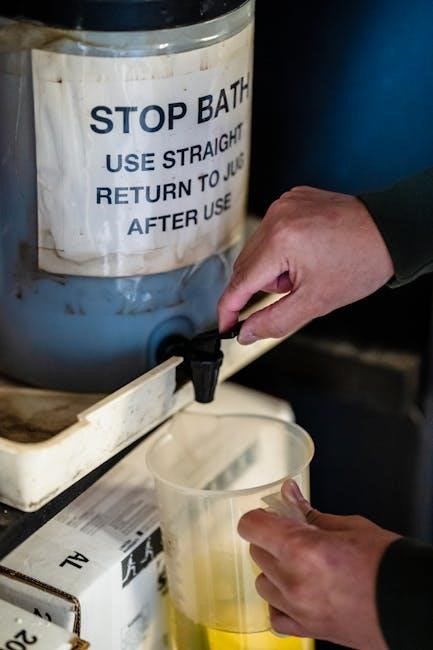
Basic Laboratory Techniques
Mastering basic lab techniques is crucial for accurate experiments. This includes precise measurement, titration, and handling of materials. These skills ensure safety and reliable results in chemistry labs.
Measurement and Accuracy in Lab Experiments
Accurate measurement is critical in chemistry experiments to ensure reliable results. Use calibrated glassware and digital instruments for precise readings. Record data immediately to avoid errors. Key practices include using appropriate units and significant figures. Techniques like proper pipetting and minimizing spills enhance accuracy. Regularly verify instrument calibration to maintain consistency. Refer to lab manuals for specific methods, ensuring adherence to safety and procedural guidelines. Practice improves precision, a cornerstone of successful lab work in chemistry. Always follow established protocols for consistent outcomes.
Titration and Volumetric Analysis
Titration is a fundamental technique in chemistry for determining the concentration of a solution. It involves reacting a known concentration of a standard solution (titrant) with an analyte of unknown concentration. Volumetric analysis relies on precise measurements of volume using burettes and pipettes. Key steps include preparing standard solutions, calibrating equipment, and accurately recording readings. Techniques like endpoint detection ensure precise results. Regular practice enhances skill in achieving accurate titrations, essential for quantitative analysis in chemistry labs. Always follow lab manual guidelines for optimal outcomes.
Heating and Cooling Techniques in the Lab
Heating and cooling techniques are essential in chemistry labs for controlling reaction conditions. Common methods include using Bunsen burners, hot plates, and water or ice baths. Proper safety measures, such as wearing gloves and goggles, are crucial to prevent burns or exposure. Techniques like refluxing and cooling with ice-salt baths are used to maintain specific temperatures. Always follow lab manual guidelines for safe handling of equipment and substances. These methods ensure accurate results and prevent hazardous situations during experiments.
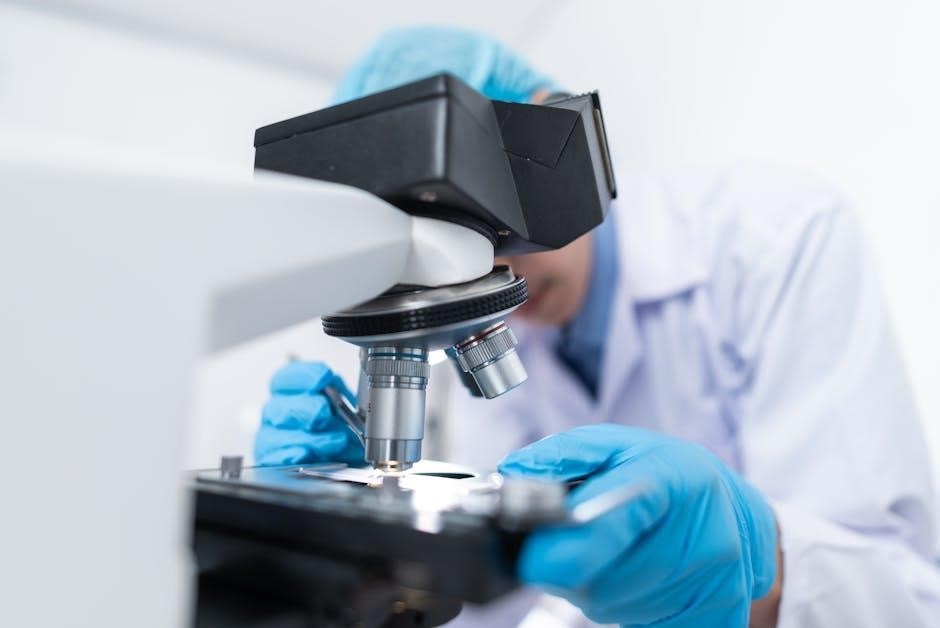
Chemical Experiments and Procedures
Chemical experiments and procedures are designed to explore fundamental principles, fostering hands-on learning and practical application of theoretical concepts in a controlled laboratory environment.
Welcome to the world of chemistry lab experiments! This section is designed for newcomers, providing a foundation in basic laboratory skills and safety protocols. Beginners will learn to identify and use essential equipment, measure chemicals accurately, and observe chemical reactions. Start with simple experiments, such as testing the properties of substances or exploring chemical changes. These exercises build confidence and prepare you for more complex procedures. Always follow safety guidelines and lab manuals to ensure a safe and successful experience. Practice and patience will help you master these fundamental techniques and foster a deeper understanding of chemistry concepts.
Quantitative Analysis Experiments
Quantitative analysis experiments focus on measuring the amount of a substance in a sample. These experiments teach you to determine concentrations, calculate percentages, and identify unknown compounds. Techniques like titration, gravimetric analysis, and spectroscopy are commonly used. For example, determining the percentage of water in Epsom salt or identifying the formula of a copper supplement are classic quantitative exercises. These experiments emphasize accuracy, precision, and proper data interpretation. They are essential for developing skills in analytical chemistry and applying scientific principles to real-world problems. Always follow lab manuals for step-by-step guidance.
Qualitative Analysis and Identification of Substances
Qualitative analysis experiments focus on identifying the components of a substance rather than their quantities. Techniques like chemical reactions, chromatography, and spectroscopy are used to detect specific ions, functional groups, or elements in a sample. For example, identifying the chemical properties of alcohols and phenols or analyzing the composition of unknown compounds are common exercises. These experiments enhance observational and analytical skills, teaching you to interpret reactions and data to determine the presence of specific substances in a sample. Proper lab techniques and safety protocols are emphasized throughout.
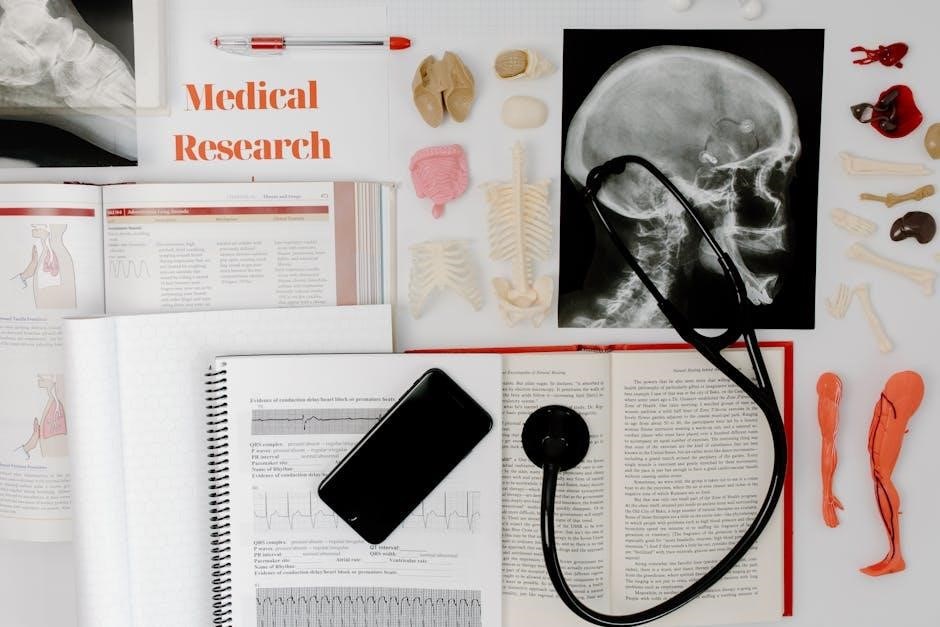
Data Analysis and Reporting
Data analysis involves interpreting experimental results to draw meaningful conclusions. Accurate calculations, graphical representations, and proper documentation are essential. Reporting includes organizing data clearly, ensuring precision, and discussing implications, fostering scientific communication and critical thinking skills in chemistry experiments.
Keeping a Laboratory Notebook
A laboratory notebook is a critical record of all experimental activities. It should include dated entries, clear objectives, materials used, step-by-step procedures, observations, data, and conclusions. Accuracy and organization are essential, as notebooks serve as legal and historical documents. Use standardized formats for consistency. Record raw data without interpretation. Note any unexpected results or errors. Regularly review and update entries. Proper documentation ensures reproducibility and accountability in scientific work. Maintain neatness by avoiding erased or altered entries for credibility.
Interpreting and Presenting Experimental Data
Interpreting experimental data involves analyzing results to draw meaningful conclusions. Use graphs, charts, and tables to present findings clearly. Ensure accuracy by double-checking calculations and identifying potential errors. When presenting data, focus on trends, patterns, and relationships. Use clear captions and labels for visuals. Highlight key insights and compare results with expected outcomes. Document all interpretations thoroughly in your lab report. Proper presentation enhances understanding and communicates results effectively to others. Accuracy and clarity are essential for valid scientific communication.
Writing Effective Lab Reports
Writing effective lab reports involves clear and concise communication of experimental procedures, results, and conclusions. Include an introduction, materials list, procedures, data analysis, and discussion. Use proper scientific terminology and maintain objectivity. Ensure accuracy in recording observations and calculations. Graphs and tables can enhance data presentation. Conclude by interpreting results and discussing their implications. Proofread for clarity and grammar to ensure professional quality. A well-structured lab report demonstrates understanding and critical thinking, making it a vital skill for scientific communication;
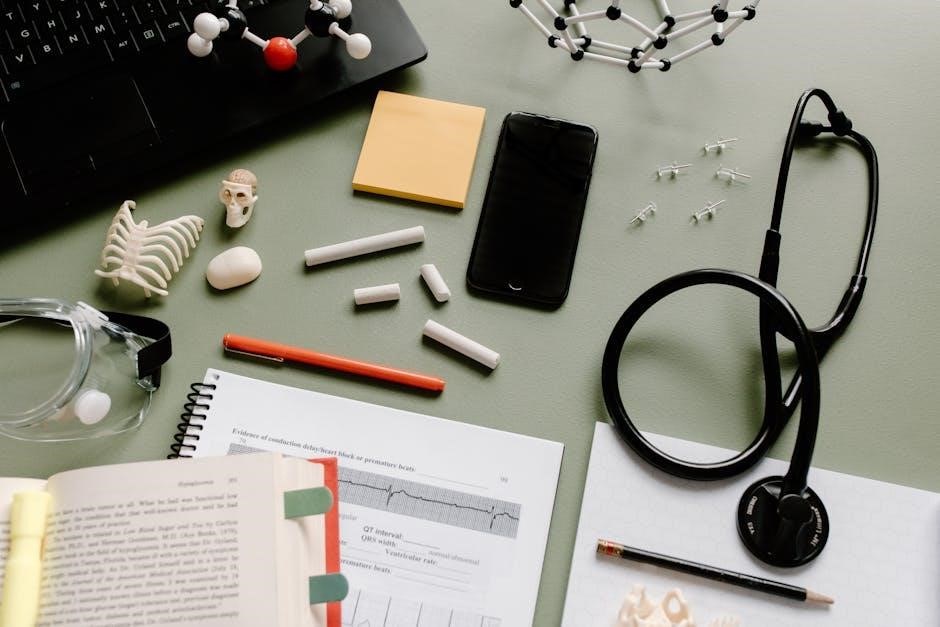
Environmental and Ethical Considerations
Adopt green chemistry practices to minimize waste and reduce environmental impact. Proper disposal of chemicals and ethical conduct in research are essential for sustainable and responsible lab operations.
Green Chemistry and Sustainable Practices
Green chemistry emphasizes minimizing waste and reducing environmental impact through sustainable practices. Key principles include atom economy, reducing hazardous substances, and using eco-friendly solvents. Laboratories should adopt energy-efficient equipment and promote recycling of chemicals. Sustainable practices also involve using renewable resources and biodegradable materials. Implementing these strategies ensures environmentally responsible lab operations while maintaining scientific integrity and safety standards. Students and researchers are encouraged to explore innovative methods that align with green chemistry principles, fostering a culture of sustainability in all laboratory activities.
Waste Disposal and Environmental Safety
Proper waste disposal is critical to maintaining environmental safety in chemistry laboratories. Hazardous chemicals, broken glassware, and contaminated materials must be segregated and disposed of according to local and international regulations. Use labeled containers for different types of waste, such as organic solvents or heavy metals. Ensure all disposal methods comply with environmental protection laws to minimize ecological impact. Proper training on waste management is essential for all lab personnel to prevent accidents and promote a culture of safety and sustainability. Always document waste disposal processes for accountability and compliance.
Ethical Conduct in Laboratory Research
Ethical conduct in laboratory research is essential to ensure integrity, accountability, and responsible scientific practices. Always maintain honesty in data collection, recording, and reporting. Properly cite sources and avoid plagiarism. Respect intellectual property and adhere to institutional guidelines. Ensure experiments are conducted with minimal environmental impact and comply with safety regulations. Treat laboratory resources responsibly and promote a culture of transparency and fairness. Ethical practices foster trust and credibility in scientific work, contributing to advancements that benefit society. Upholding these principles is a shared responsibility for all researchers.

Digital and Online Resources
Digital and online resources offer comprehensive support for chemistry lab work, providing eTextbooks, interactive simulations, and virtual labs. These tools enhance learning through 24/7 accessibility.
Online Lab Manuals and Their Benefits
Online lab manuals are valuable resources for chemistry students and educators, offering 24/7 access to experiment procedures, safety guidelines, and interactive simulations. Many institutions, like Santa Monica College, provide customizable digital manuals that can be adapted for specific courses. These manuals often include downloadable PDFs, videos, and virtual labs, enhancing hands-on learning. They also promote consistency in teaching methods and allow instructors to update content easily. Online manuals are eco-friendly and cost-effective, reducing reliance on physical copies while ensuring up-to-date information is always available.
Interactive Simulations and Virtual Labs
Interactive simulations and virtual labs are innovative tools that enhance chemistry education by providing immersive learning experiences. These platforms allow students to conduct virtual experiments, explore chemical reactions, and analyze data in a controlled digital environment. Virtual labs simulate real-world laboratory conditions, enabling students to practice techniques and observe phenomena without physical constraints. They also offer step-by-step guidance, making complex concepts more accessible. Such resources are particularly beneficial for remote learning, fostering engagement and understanding of chemical principles through hands-on, interactive exploration.
Accessing and Utilizing Digital Lab Resources
Digital lab resources are readily available online, offering a wealth of information for chemistry students. Institutions like Santa Monica College provide online lab manuals with detailed procedures and safety guidelines. Students can access PDF documents, interactive simulations, and virtual labs to supplement their learning. These resources often include pre-lab assignments, step-by-step instructions, and post-lab reporting templates. Utilizing these tools effectively requires adherence to institutional guidelines, proper citation, and acknowledgment of sources. They serve as invaluable companions for both remote and in-person laboratory experiences, enhancing understanding and skill development.
Lab Setup and Organization
Designing an efficient laboratory workspace involves organizing chemicals, equipment, and supplies for easy access and safety. A clean, well-maintained environment ensures productivity and adherence to safety protocols.
Designing an Efficient Laboratory Workspace
Designing an efficient laboratory workspace involves strategic planning to optimize workflow and safety. Start by assessing the lab’s purpose and frequency of use to determine layout needs. Position essential equipment, such as fume hoods and workstations, in accessible locations. Ensure adequate storage for chemicals and supplies, labeling them clearly for easy identification. Incorporate ergonomic furniture to reduce fatigue and improve comfort. Implement a logical traffic flow to minimize congestion and prevent accidents. Regularly review and adjust the layout as lab activities evolve to maintain efficiency and safety.
Organizing Chemicals and Supplies
Organizing chemicals and supplies is crucial for efficiency and safety in the laboratory. Begin by categorizing chemicals based on their type, hazard level, and frequency of use. Label storage areas clearly and ensure all containers are properly marked with chemical names and hazard information. Use shelving and cabinets to store items, keeping heavier objects at lower levels. Maintain a centralized location for frequently used supplies, such as gloves and glassware; Regularly inventory stock to avoid shortages and expired materials, ensuring a well-maintained and accessible workspace.
Cleanliness and Maintenance of the Lab Environment
Maintaining a clean and organized laboratory environment is essential for safety, efficiency, and accuracy in experiments. Clean workstations thoroughly before and after use, and dispose of waste properly. Regularly sanitize surfaces and equipment to prevent contamination. Schedule periodic deep cleaning of storage areas, shelves, and instruments. Ensure all materials are neatly labeled and stored in designated zones. Conduct routine inspections to identify and address potential maintenance issues, such as leaky faucets or faulty equipment. A well-maintained lab fosters a productive and safe workspace for everyone.
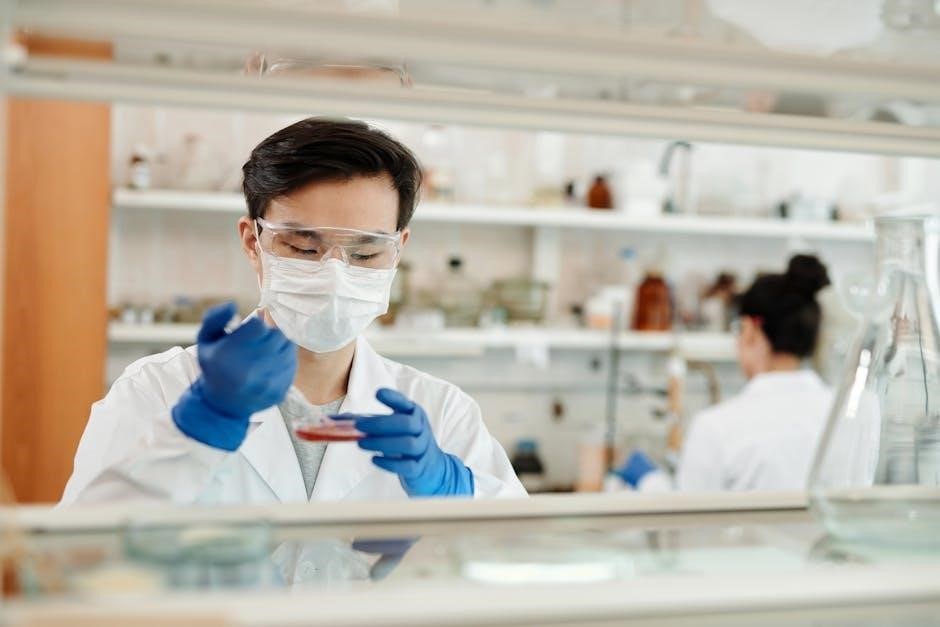
Common Challenges and Troubleshooting
Laboratory work often presents challenges like experimental errors, equipment malfunctions, and unexpected results. Preparedness, problem-solving skills, and reliance on lab manuals are key to overcoming these issues effectively.
Identifying and Solving Experimental Errors
Experimental errors in chemistry labs often arise from improper calibration, incorrect measurements, or environmental factors. To identify these issues, carefully review procedures and data analysis. Common mistakes include miscalculations, mislabeling samples, or using contaminated reagents. To solve these, recalibrate equipment, repeat measurements, and ensure precise adherence to lab manual instructions. Documenting observations and consulting with instructors or lab manuals can help resolve discrepancies. Regular practice and attention to detail are key to minimizing errors and achieving accurate results in laboratory experiments.
Dealing with Equipment Malfunctions
Equipment malfunctions in the chemistry lab can disrupt experiments and pose safety risks. If a device fails, immediately stop the experiment and notify your instructor. Consult the lab manual or manufacturer’s guide for troubleshooting steps. Avoid attempting repairs without proper training. In cases of severe malfunctions, evacuate the area if necessary and report the issue. Regular maintenance and inspections can help prevent such occurrences. Always follow safety protocols to ensure a secure working environment while addressing equipment issues.
Overcoming Common Lab-Related Challenges
Laboratory work often presents challenges such as unexpected results, equipment issues, or procedural misunderstandings. To address these, thoroughly review lab manuals and seek guidance from instructors. Proper preparation, including pre-lab readings and calculations, can minimize errors. Maintaining organization, following safety protocols, and keeping detailed records are essential. Stay calm and methodical when encountering problems, and leverage resources like lab guides or peer collaboration for solutions. Continuous practice and adaptability enhance problem-solving skills in the lab environment.
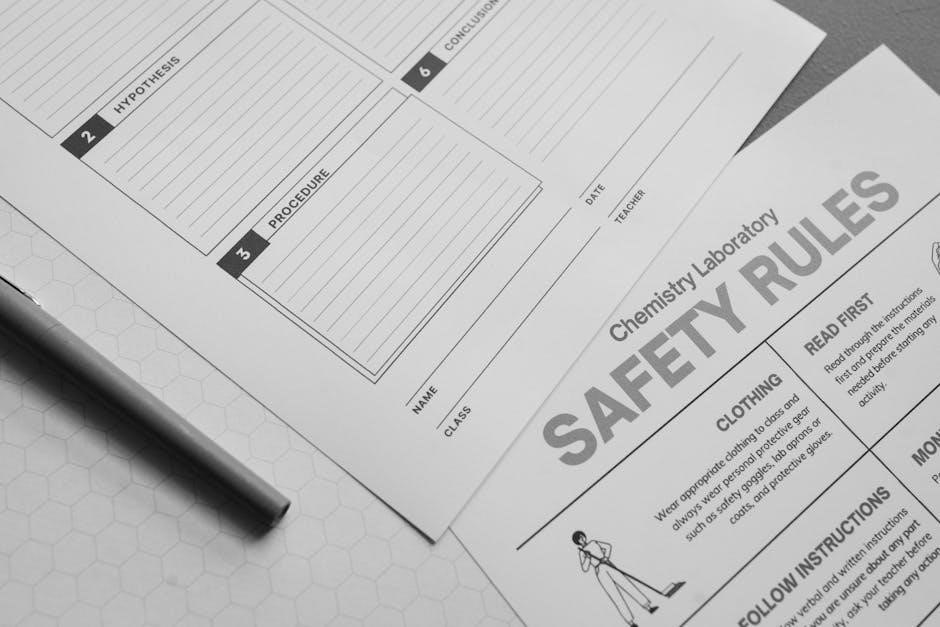
Best Practices for Effective Lab Work
Adhere to lab manuals, follow safety protocols, and use proper techniques to ensure accurate results. Maintain organization, document observations, and seek guidance when needed for optimal outcomes.
Time Management in the Laboratory
Effective time management is crucial for maximizing productivity in the lab. Always review procedures beforehand and complete pre-lab assignments to ensure preparedness. Create a schedule for each experiment, prioritizing tasks to avoid rushing. Minimize distractions by staying focused on objectives. Keep materials and equipment organized to save time during experiments. Record data promptly and cleanly to avoid delays. Regularly clean and maintain your workspace to enhance efficiency. By managing time wisely, you can achieve accurate results and make the most of your laboratory experience.
Collaboration and Communication in Lab Settings
Collaboration and clear communication are essential in laboratory settings to ensure safety, accuracy, and efficiency. Teamwork fosters a supportive environment where ideas and responsibilities can be shared. Always discuss roles, procedures, and expected outcomes with lab partners to avoid misunderstandings. Active listening and precise instructions help prevent errors. Regularly update your team on progress and challenges. Documenting findings collectively ensures shared understanding and accountability. Effective communication also enhances problem-solving and promotes a positive learning experience in the lab.
Continuous Learning and Skill Development
Continuous learning and skill development are crucial for mastering chemistry laboratory techniques; Regular practice and hands-on experience refine experimental skills, improving accuracy and efficiency. Staying updated with new methodologies and technologies enhances problem-solving abilities. Engaging in workshops, reading scientific literature, and participating in training sessions fosters professional growth. Documenting progress in a lab notebook helps track improvements and identify areas for further development. Embracing lifelong learning ensures adaptability and excellence in laboratory research, leading to innovative discoveries and a deeper understanding of chemical principles.
This manual provides a comprehensive guide to chemistry laboratory practices, emphasizing safety, precision, and continuous learning. It equips students with essential skills for future scientific exploration.
Summarizing Key Takeaways
This manual emphasizes the importance of safety, precision, and proper techniques in chemistry labs. It highlights essential skills such as accurate measurements, equipment handling, and data analysis. Key concepts include maintaining a well-organized lab notebook, understanding error analysis, and adhering to safety protocols. The manual also underscores the value of environmental awareness and ethical practices in laboratory work. By mastering these principles, students can confidently approach experiments, ensuring both personal safety and the integrity of their results. Continuous learning and practice are encouraged to refine skills and deepen understanding of chemistry principles.
Encouraging Further Exploration and Practice
Exploring beyond the manual enhances your chemistry skills and understanding. Utilize online resources, simulations, and virtual labs to deepen your knowledge. Regular practice with experiments and problem-solving exercises reinforces concepts. Engage with study groups and seek mentorship for guidance. Stay curious and embrace challenges to refine your techniques. Continuous learning and hands-on practice are key to mastering chemistry. Encourage peers to join you in exploring the fascinating world of chemistry, fostering a collaborative and innovative learning environment.

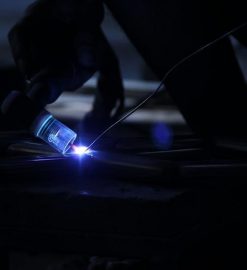

Leave a Reply
You must be logged in to post a comment.